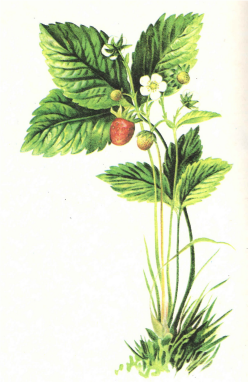A perennial herbaceous plant with a short, thick, dark-brown, oblique rhizome covered in fine roots and long, thin above-ground creeping shoots. These shoots root at nodes, enabling vegetative reproduction. The basal leaves are long-petioled and trifoliate, with leaflets that are obovate or rhombic, coarsely toothed, dark green on top, and bluish-green with appressed hairs on the underside. The stems are thin, slightly taller than the basal leaves, and have 1–2 small, underdeveloped, simple leaves.

The inflorescence is terminal, few-flowered, and resembles a corymb. The flowers are bisexual, with a calyx and an epicalyx, each composed of 5 segments. There are 5 white petals, and numerous stamens and pistils. The fruit is drooping and false, formed from an enlarged, conical or ovoid, juicy, red receptacle, dotted with numerous small, dry, nut-like seeds. It is commonly called a berry — Fructus Fragariae. The berry is supported by a calyx and an epicalyx with reflexed and slightly bent-back sepals. Flowering occurs in May–June, with fruit ripening in July–August.
This species grows nearly across the entire country, thriving in meadows, forest clearings, forests, and grassy slopes.
The berries contain sugars, pectins, malic and other organic acids, vitamin C, vitamin B, anthocyanins, and more. They are used fresh or dried for liver and bile duct disorders. Fresh leaves contain 250–280 mg% of vitamin C and are used in vitamin-rich beverages and as a diuretic. Occasionally, the rhizome, rich in tannins, is used as an astringent and diuretic. An infusion of wild strawberry leaves contains a high concentration of ascorbic acid (vitamin C), which gives it antiscorbutic properties. It also slows the heart rate, strengthens heart contractions, and dilates blood vessels.
Wild strawberry tea is prepared by crushing 20 g of leaves, pouring a cup of boiling water over them, boiling for 5–10 minutes, and steeping for 2 hours. It is consumed in 1 tablespoon doses, 3–4 times a day.
When harvesting fruits for medicinal purposes, similar species should not be collected: Fragaria viridis and Fragaria moschata.
Other Similar Species
Fragaria viridis Duch. (Green Strawberry or Barren Strawberry): The fruits are nearly spherical, yellowish-white, with a red tip, and the calyx and epicalyx are appressed to the fruit. It grows in almost the same regions.
Fragaria moschata Duch. (Musk Strawberry or Strawberry): A dioecious plant with unisexual flowers and densely hairy leaves on both sides. The fruits are very fragrant, whitish with a red side, and grow wild only in the European part. Musk strawberry is often cultivated.
